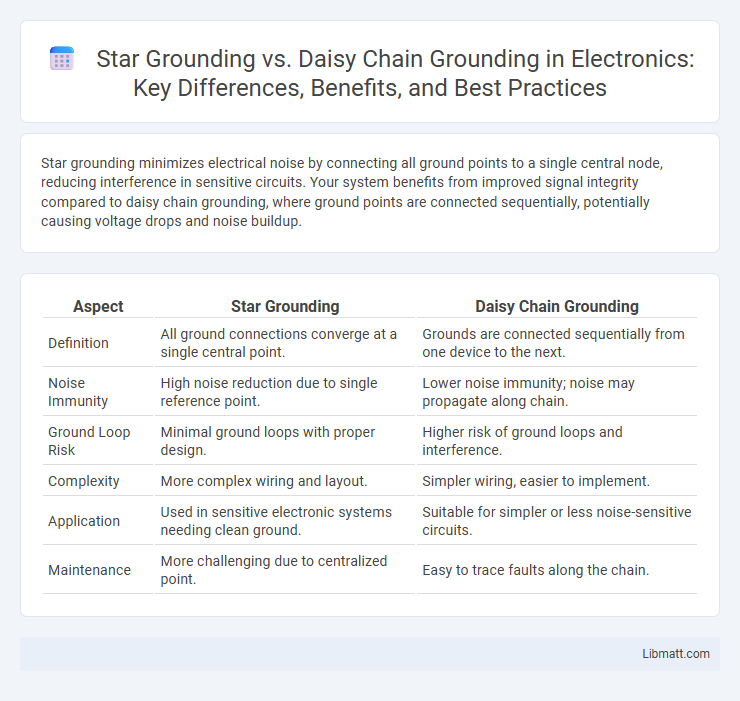Star grounding minimizes electrical noise by connecting all ground points to a single central node, reducing interference in sensitive circuits. Your system benefits from improved signal integrity compared to daisy chain grounding, where ground points are connected sequentially, potentially causing voltage drops and noise buildup.
Table of Comparison
| Aspect | Star Grounding | Daisy Chain Grounding |
|---|---|---|
| Definition | All ground connections converge at a single central point. | Grounds are connected sequentially from one device to the next. |
| Noise Immunity | High noise reduction due to single reference point. | Lower noise immunity; noise may propagate along chain. |
| Ground Loop Risk | Minimal ground loops with proper design. | Higher risk of ground loops and interference. |
| Complexity | More complex wiring and layout. | Simpler wiring, easier to implement. |
| Application | Used in sensitive electronic systems needing clean ground. | Suitable for simpler or less noise-sensitive circuits. |
| Maintenance | More challenging due to centralized point. | Easy to trace faults along the chain. |
Introduction to Grounding in Electrical Systems
Grounding in electrical systems ensures safety by providing a reference point for voltage levels and a path for fault currents. Star grounding involves connecting all grounding points to a single centralized ground, minimizing ground loop issues and interference. Daisy chain grounding links multiple grounding points sequentially, which can cause potential differences and increased noise in sensitive equipment.
What is Star Grounding?
Star grounding is an electrical grounding technique where all ground connections converge at a single central point, minimizing the risk of ground loops and electrical noise. This method ensures that each component's ground path is independent, helping to maintain signal integrity and reduce interference in complex circuits. Your system benefits from improved stability and reduced electromagnetic interference when using star grounding in sensitive electronic applications.
What is Daisy Chain Grounding?
Daisy chain grounding refers to connecting multiple electrical devices or components in a series, where the ground wire runs from one device to the next in a sequential manner. This method can lead to ground loops, increased electrical noise, and potential interference due to the shared ground path. Your electrical system's stability improves when alternative grounding methods, like star grounding, minimize these risks by providing a direct, individual path to a central ground point.
Key Differences Between Star and Daisy Chain Grounding
Star grounding features a central grounding point where all conductors connect individually, minimizing ground loops and electrical noise, making it ideal for sensitive electronic systems. Daisy chain grounding connects devices sequentially, which can introduce voltage drops and interference, potentially compromising system performance in high-precision environments. The primary distinction lies in star grounding's ability to maintain equal ground potential across all points, whereas daisy chain grounding risks fluctuating potentials due to the series connection of grounds.
Advantages of Star Grounding
Star grounding offers superior noise reduction by providing a single, central grounding point, which minimizes ground loops and interference in electrical systems. This configuration enhances signal integrity, improving performance in sensitive electronic equipment. Your setup benefits from easier fault isolation and improved safety due to the clear, organized grounding structure.
Advantages of Daisy Chain Grounding
Daisy chain grounding offers the advantage of simplicity and cost-effectiveness in installations by reducing the amount of wiring needed compared to star grounding. This method allows easier expansion and modification since components are connected sequentially along a single path. Your system benefits from lower initial setup costs and straightforward troubleshooting due to a more linear grounding layout.
Common Applications for Each Grounding Method
Star grounding is commonly used in audio systems, computer systems, and industrial control panels where minimizing ground loop interference is critical. Daisy chain grounding finds application in low-current circuits like lighting systems, simple sensor networks, and automotive wiring due to its straightforward installation. You should choose star grounding for sensitive electronics requiring stable reference points, while daisy chain grounding suits less sensitive, cost-effective setups.
Potential Issues and Noise Concerns
Star grounding minimizes potential issues by ensuring each ground connection runs independently to a common point, reducing ground loops and noise interference. Daisy chain grounding can introduce noise concerns due to shared ground paths, causing voltage drops and unwanted interference between components. Improper daisy chain grounding often results in increased electromagnetic interference (EMI) and signal degradation in sensitive electronic circuits.
Best Practices for Implementing Grounding Techniques
Star grounding minimizes ground loops and interference by connecting all ground points directly to a single central node, making it ideal for sensitive electronic systems. Daisy chain grounding links components in series, which can introduce noise and voltage drops, so it should be limited to less critical circuits or short distances. Best practices include using low-impedance conductors, maintaining short ground paths, and ensuring a single, well-defined ground reference to enhance signal integrity and system stability.
Choosing the Right Grounding System for Your Project
Star grounding systems minimize ground loop interference by connecting all grounds directly to a single point, enhancing signal integrity in sensitive electronic projects. Daisy chain grounding links components sequentially, simplifying wiring but increasing the risk of noise and voltage drops that can affect performance. Evaluating the complexity, noise sensitivity, and layout of your project is crucial to choosing between star grounding's superior noise reduction and daisy chain grounding's ease of implementation.
Star grounding vs Daisy chain grounding Infographic

 libmatt.com
libmatt.com